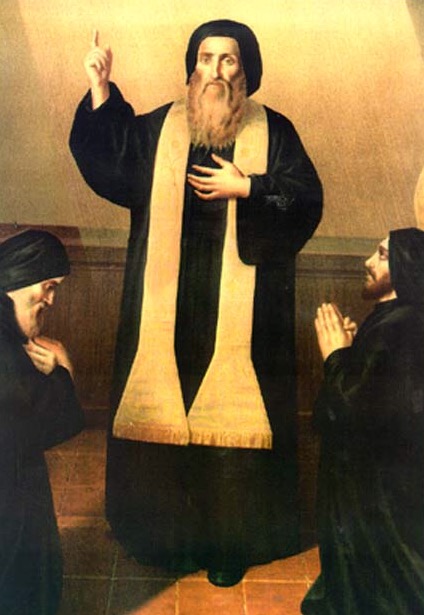History
St Charbel Brief History
May 8th, 1828
St Charbel’s birth in Bekaa Kafra, North Lebanon.
May 16th, 1828
St Charbel is baptised as a Catholic Maronite in Bekaa Kafra, North Lebanon.
1851
St Charbel’s first year of noviciate at Our Lady of Mayfouk Monastery, Mount Lebanon.
1852
St Charbel’s second year of noviciate at St Maroun’s Monastery in Annaya, Mount Lebanon.
1853
St Charbel takes his first vows at St Maroun’s Monastery in Annaya, Mount Lebanon.
1853-1859
St Charbel begins his theological studies at St Cyprian and St Justina Monastery in Kfifan, North Lebanon.
1859
St Charbel is ordained as a Catholic Maronite Priest in Bkerke, Mount Lebanon.
1859-1875
St Charbel starts his life as a Catholic Maronite Priest at St Maroun’s Monastery in Annaya, Mount Lebanon.
February. 15th, 1875
St Charbel becomes a Hermit and enters the Hermitage of St Peter and St Paul in Annaya, Mount Lebanon.
December. 24th, 1898
St Charbel’s death at the Hermitage of St Peter and St Paul in Annaya, Mount Lebanon.
December. 25th, 1898
St Charbel’s burial at St Maroun’s Monastery in Annaya, Mount Lebanon.
1899
St Charbel’s tomb was opened due to a bright and dazzling light coming out of the tomb.
1927
St Charbel’s body was transferred to a third grave.
1950
St Charbel’s grave was opened and his body was exposed to visitors. A distinguished year full of miracles around his grave.
December 5th, 1965
St Charbel’s Beatification to become a Saint at the Vatican, Rome.
October 9th, 1977
St Charbel’s Canonisation as a Saint at the Vatican, Rome.

ST CHARBEL DETAILED HISTORY
St Charbel History Part 1: Birth & Childhood
ST CHARBEL BIRTHPLACE IN BEKAA KAFRA, NORTH LEBANON
On May 8, 1828 in a mountain village of Bekaa kafra, North Lebanon, the highest village in Lebanon, Youssef Antoun Makhlouf (St Charbel) was born to a poor Catholic Maronite family. Youssef (St Charbel) was the youngest of five children born to Antoun Zaarour Makhlouf and Brigitta Elias Chidiac. His brothers were Hanna and Beshara and his sisters were Koun and Warde. His father died when he was 3 years old.
Like many of the Christians from the Lebanese Mountain, his father had been taken away from his family by the Turks and forced into hard labor. Antoun was required to transport the harvest on his donkey to the Emir (Prince). On his way back to his hometown, he developed a high fever and subsequently died. Antoun was buried in Gherfeen, Mount Lebanon, where he had fallen ill, his family was unable to pay its last respects.
With his father’s premature death, his mother became responsible for the welfare of her five children during another brutal period. She was a religious woman of strong character. In Bekaa Kafra, Brigitta was renowned for daily fasting and praying the rosary. She was engaged in silk weaving like many other women of the village.
Upon the death of their father and in accordance with the custom of the times, Youssef (St Charbel) and his siblings were placed under the guardianship of their paternal uncle, Tanious Zaarour Makhlouf. Two years later, the widowed Brigitta married Deacon Lahoud, son of Girgis Ibrahim Makhlouf, who later became a priest under the name of Abdel-Ahad. She had two more children, Noah and Tannous.
Father Abdel-Ahad, Brigitta and the children lived together as a devout Christian family. Brigitta continued to raise her children with love, faith and piety. Youssef (St Charbel) and his siblings were used to prayer, fasting and attending Mass every day. Under the care of his stepfather, Youssef (St Charbel) grew spiritually as he assisted him at Mass and in serving the community.
Youssef (St Charbel) studied at the parish school and tended the family cows. He spent a great deal of time outdoors in the fields and pastures in his village and he meditated amid the inspiring views of boundless valleys and proud mountains. He spent many hours in prayer at his village grotto near the fields praying in front of a photo of the Virgin Mary bringing with him flowers, incense and a candle.
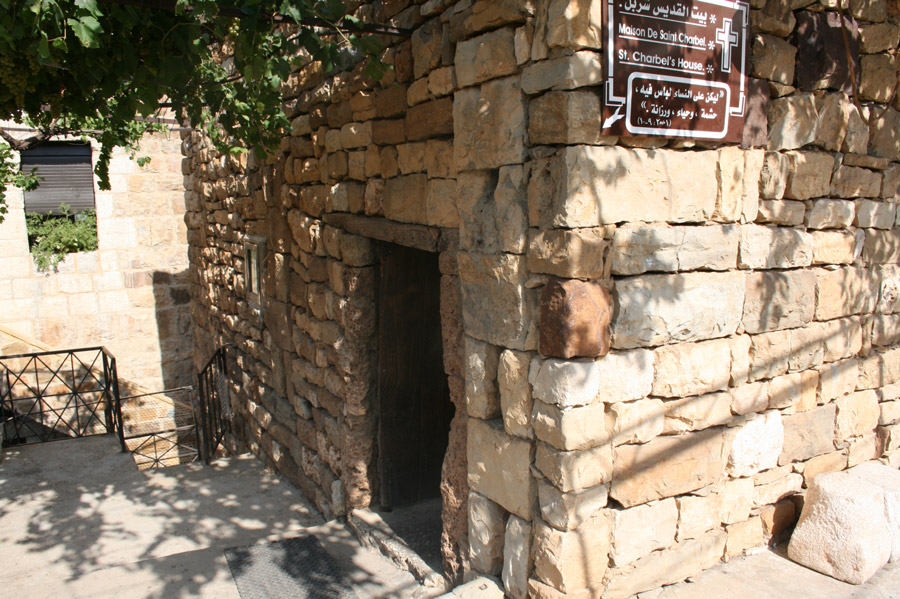
ST CHARBEL HISTORY (PART 2): ROLE MODELS
ST CHARBEL UNCLE’S WERE HERMITS AT THE MONASTERY OF ST ANTONIOS OF KOZHAYA IN NORTH LEBANON
Youssef (St Charbel) had several good role models within his family. In addition to his religious parents and his stepfather, his maternal uncles Augustin and Daniel Chidiac were hermits at the Catholic Maronite Monastery of St Antonios in Kozhaya, North Lebanon which comprises of natural caves and sandstone buildings.
St Antonios of Kozhaya is considered to be one of the oldest monasteries of the Qadisha Valley. Several hermitages are attached to it and at a certain period (approx 12th century AD), it was the See of the Catholic Maronite Patriarch. In 1708, it was handed down to the newly formed Lebanese Maronite Order and it still belongs to this Order.
Youssef (St Charbel) would walk 4 hours from his village of Bekaa Kafra to visit them, follow their example and accept their guidance. He was so impressed by his uncle’s devotion and commitment to their faith.
His uncle Tanious and his mother were worried Youseff (St Charbel) would follow in the footsteps of his maternal uncles Augustin and Daniel Chidiac. Often, he said that he wanted to become a monk, but his uncle and mother were completely opposed and tried to change his mind.
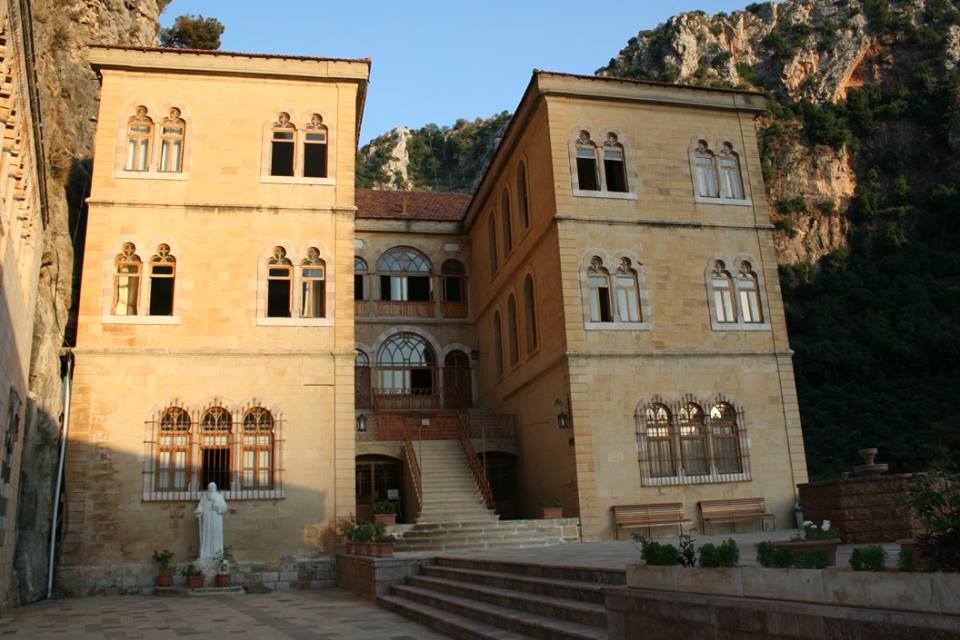
ST CHARBEL HISTORY (PART 3): NOVITIATE
ST CHARBEL LEAVES HOME TO BECOME A NOVICE AT OUR LADY OF MAYFOUK MONASTERY IN MOUNT LEBANON
From early childhood, Youssef (St Charbel) showed that he loved prayer and solitude. In 1851 at age 23, without informing anyone, he left home and started walking to the Monastery of Our Lady of Mayfouk in Mount Lebanon to become a novice.
Tannous, his uncle and guardian, wanted Youssef to continue working with him. His mother wanted him to marry the young woman who loved him.
Our Lady of Mayfouk Monastery was a Catholic Maronite Patriarchal seat for hundreds of years and now is a national archeological site in Lebanon. Next to the Monastery is an ancient church called Our Lady of ILIGE dating back a few hundred years with one of the oldest portraits of Our Lady.
When Youssef (St Charbel) arrived at the Monastery of Our Lady of Mayfouk he changed his name to Brother Charbel, after an early 2nd century Christian Martyr of the Antiochian Church.
Brother Charbel (St Charbel) was filled with determination and was happy in his new home- “the Monastery”, his new family- “the Lebanese Maronite Order” and his new bride – “the Church”.
The Lebanese Maronite Order of monks is the embodiment of the ancient eastern monasticism, which since early Christian times existed and thrived within widely dispersed, independent monasteries. In 1695, Lebanese Maronite monasticism was united under one order by the monk, ‘Abdallah al-Qaraali’ and his fellows.
After long hours of prayer, fasting and labour, Brother Charbel (St Charbel) was transferred from the Monastery of Our Lady of Mayfouk to the Monastery of St Maroun in Annaya, Mount Lebanon to further his studies and to continue on the road of becoming a Monk.

ST CHARBEL HISTORY (PART 4): BROTHERHOOD
ST CHARBEL IS TRANSFERRED TO ST MAROUN’S MONASTERY IN ANNAYA, MOUNT LEBANON
In 1853, two years after Brother Charbel (St Charbel) novitiate began at Our Lady of Mayfouk Monastery and completed at the St Maroun Monastery in Annaya, Mount Lebanon, the Monastery council under the patronage of its Superior met to consider his request to become a monk. He was accepted and therefore would take the monastic vows.
In the Mass on November 1, 1853 and in the presence of the superior, the novice master and the monks of the monastery, Brother Charbel (St Charbel) took the monastic vows. Neither the monk’s family nor the public were allowed to attend this solemn occasion. Only the monastic family was present.
During Mass, the Superior questioned Brother Charbel (St Charbel) about his readiness to observe all his vows. After giving affirmative replies, Brother Charbel (St Charbel) then pronounced his monastic oath: “I, Brother Charbel, promise God Almighty, in the presence of my Most Reverend Father General, to commit myself to obedience, chastity and voluntary poverty until death, according to our Rule and Order.”
After pronouncing his vows, his hair was cut to show his dedication. He was then dressed in the black monastic habit, the angelic cowl (hood), the belt of the Order, the tassel and the habit. Each of these has its own special meaning and is an important symbol in the novitiate’s transition to monkhood.
Black represents dying to the world. The black garb means that the monk has withdrawn from the world and all things worldly. By wearing the habit, the cloth of the poor, the monk proclaims his poverty.
The angelic cowl is what the angel gave to Saint Anthony the Great. It symbolises the purity of the monk, who has forsaken the world and renounced his desire for marriage and children. By wearing the cowl, the monk proclaims his chastity and celibacy, his total commitment to the will of God.
The belt symbolises the monk’s fidelity and chastity. The black tassel reminds us of the whip used to scourge Jesus. Every time the monk touches the tassel, he says “With your pain, O Jesus Christ.” The robe symbolises the plea to God to protect the monk. It means that the monk is in God’s care.
After being vested, Brother Charbel (St Charbel) carried a cross in his left hand in response to Christ’s call to “take up your cross and follow me” and a candle in his right hand to symbolise Christ, “the light of the world”. He was then led in a procession to the church to show the community’s joy that it had a new member.
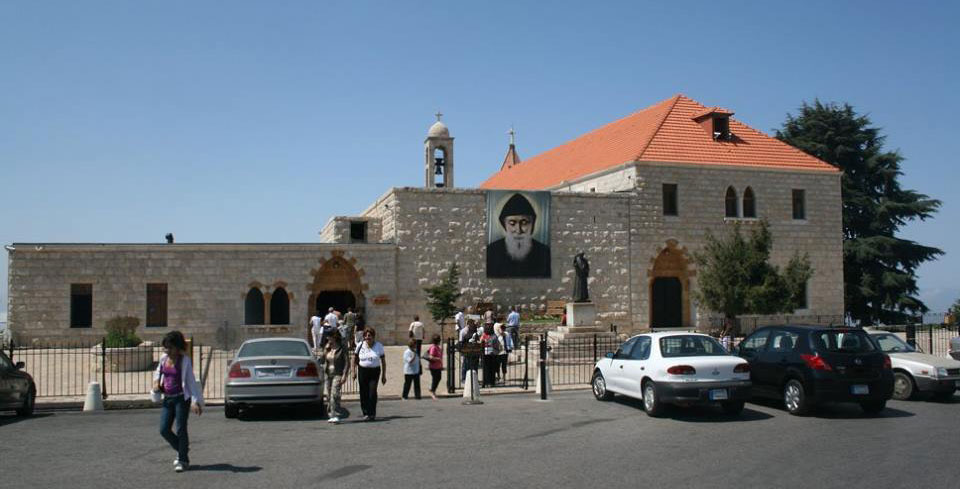
ST CHARBEL HISTORY (PART 5): EDUCATION
ST CHARBEL IS TRANSFERRED TO THE MONASTERY OF ST CYPRIAN AND ST JUSTINA IN KFIFAN, NORTH LEBANON
For formation and education, Brother Charbel (St Charbel) was transferred to the Monastery of St Cyprian and St Justina in Kfifan, North Lebanon, the most important school of theology in Lebanon.
The Monastery of St Cyprian and St Justina stands at an altitude of 450 metres on a hill surrounded by various villages in Kfifan. Construction of the Monastery goes back to the 7th century and it was dedicated to the holy martyrs Cyprian and Justina in 1230AD, when Patriarch Daniel ash-Shamati (1230AD-1239AD) made it the Patriarchal seat.
Brother Charbel (St Charbel) stayed there for 6 years from 1853 to 1859, for studies in philosophy and theology. At Kfifan, he met two holy monks who were his teachers. They were Namatallah Al-Kafri and Namatallah Al-Hardini. Namatallah Al-Hardini was renowned and religious reformer whose imprint on the Lebanese Maronite Order still remains today. St Namatallah Al-Hardini was canonised by His Holiness John Paul II in Rome.
Saint Al-Hardini became Brother Charbel’s (St Charbel) spiritual mentor. As such, Al-Hardini gave him a brilliant spiritual education, nurtured his deep love for holy monasticism and had a great influence upon Brother Charbel (St Charbel).

ST CHARBEL HISTORY (PART 6): ORDINATION
ST CHARBEL IS ORDAINED A PRIEST IN BKERKE, MOUNT LEBANON
Brother Charbel (St Charbel) was ordained as a Catholic Maronite Priest at the Maronite Patriarchate in Bkerke, Mount Lebanon in 1859. His Monastery was under the jurisdiction of the Patriarchal Vicar who resided in Bkerke at the time.
Bkerke is the See of the Catholic Maronite Patriarchate and is located 650 metres above the bay of Jounieh in Mount Lebanon. The See of the Catholic Maronite Patriarchate was originally in Antioch but due to persecution, it moved first to St Maroun’s Monastery on the Orontes River and then to varied locations in Lebanon such as Kfarhay, Yanouh, Mayfouk, Lehfed, Habeel, Kfifan, Al Kafr and Hardin.
The Catholic Maronite Patriarchate then moved to Qannoubine in the Kadisha Valley, North Lebanon because of intensified persecution and remained there from 1440 to 1823 when it moved to Dimane, North Lebanon.
Lastly, in 1830, the Catholic Maronite Patriarchate moved to Bkerke, which bought an existing Monastery, were the Patriarchate uses the Bkerke residence in winter and Dimane residence in summer.
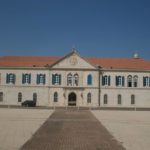
ST CHARBEL HISTORY (PART 7): PRIESTHOOD
ST CHARBEL RETURNS TO ST MAROUN’S MONASTERY IN ANNAYA, MOUNT LEBANON
After his ordination, Father Charbel (Saint Charbel) returned to St Maroun’s Monastery in Annaya, Mount Lebanon to perform his priestly ministry and monastic duties.
The Monastery belongs to the Lebanese Maronite Order and lies 17 kilometres from Jbeil and has an altitude of 1200 metres. The construction of the first part of the Monastery was completed in 1828 and between 1838 and 1841, the old Church and cellars were completed. The Order completed a new Church in 1974 which was named St Charbel’s Church.
During Father Charbel (St Charbel) 19 years in Annaya, he performed his priestly ministry and monastic duties in an edifying way. He dedicated himself totally to Christ to live, work and pray in silence. Charbel had said to his superior, “If you judge me worthy, give me the heaviest and most humiliating work.”
As he had done at Kfifan, Father Charbel (Saint Charbel) tilled, planted and harvested the crops of the community’s land in Annaya. Indeed, working the land and engaging in manual labor formed the second element in monastic life after prayer: Ora et Labora.
Working the land in the Catholic Maronite tradition, the temporal and the sacred, embodies a level of mysticism best illustrated by Father Michel Hayek. “A Maronite”, said Hayek, “works, builds, plants as if he is celebrating the liturgy. His whole economy has a sacramental taste and a liturgical savouring – the vine and the wheat for the bread and the wine of the Eucharist; the olive tree to make the holy oils; the mulberry plant to weave the altar cloth and the vestments for benediction. All of which are signs of the hereafter”.
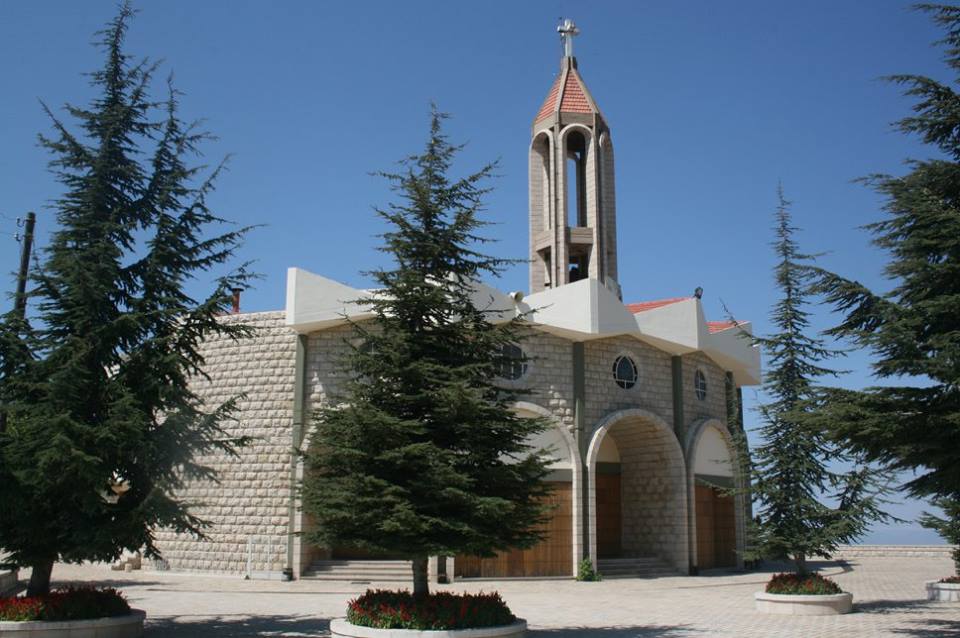
ST CHARBEL HISTORY (PART 8): HERMITAGE
ST CHARBEL IS GRANTED PERMISSION TO LIVE AS A HERMIT AT THE HERMITAGE OF ST PETER AND ST PAUL IN ANNAYA, MOUNT LEBANON
As Father Charbel (St Charbel) worked the land and performed manual labor at the St Maroun’s Monastery in Annaya, he continued a life of purity, obedience and humility that has yet to be surpassed.
In 1875, Father Charbel (St Charbel) showed “supernatural power” and was granted permission to live as a Hermit at the Hermitage of St Peter and St Paul in Annaya, Mount Lebanon which is near the Monastery of St Maroun in Annaya, Mount Lebanon.
The Hermitage of St Peter and St Paul was built as a Monastery in 1798 and became a hermitage in 1829 when the Lebanese Maronite Order decided to build the Monastery of St Maroun on a nearby property. The first monk to live as a hermit in this newly established hermitage was Father Alisha’ Al-Hardini, the brother of St Namatallah Al-Hardini who was Father Charbel’s (St Charbel) teacher and mentor at Kfifan. He was followed by Fathers Yohanna Al-‘Akoury, Yowakim Al-Zouki, Libaous Al-Ramati and Father Charbel (St Charbel) Bekaa-Kafra.
As a Hermit, Father Charbel learned and followed the rules of his Order to the letter, which include:
a) He must say Mass and visit the chapel frequently night and day.
b) He must pray, meditate and read the Holy Scriptures and Bible.
c) He must do manual labor as a powerful remedy for many temptations, as a proof that he is not deserting his human obligations and in accordance with the stern injunction of St Paul: “If anyone will not work, neither let him eat”.
d) He must live a life of strict poverty.”
Father Charbel (St Charbel) did penance alone and in silence, for the rule states:
a) The hermit can eat only one meal a day, which is sent by the monastery.
b) He must never eat meat or drink wine. During Lent he can only have vegetables with a little oil.
c) He must not sleep more than five hours.
d) He must observe strict silence. In case of necessity, he must speak briefly and in subdued tones.
e) He must not leave the hermitage without the express consent of his superior.
At the hermitage, Father Charbel (St Charbel) companions were the Son of God, as encountered in the Scriptures and in the Eucharist, and the Blessed Mother. The Eucharist became the centre of his life. Though this Father Charbel (St Charbel) did not have a place in the world but the world had a great place in his heart. Through prayer and penance he offered himself as a sacrifice so that the world would return to God.
It was in this secluded sanctuary that Father Charbel (St Charbel) spent the remaining 23 years of his life practicing severe mortification. It is recorded by his companions that he wore a hair shirt, practiced corporal punishment, chained himself, slept on the hard ground and ate only one meal a day – the leftovers from his fellow monk’s meals.
Father Charbel (St Charbel) pillow was a piece of wood covered with an old cloth, a remnant from an old habit. His bed was made of goat hair and laid directly on the floor. Although a hermit, he was not exempt from the supervision and orders of his superiors. He was to follow strict religious practices and carry out a severe ascetic way of life.
Father Charbel (St Charbel) day would start with adoration of the Eucharist, prayers and celebration of the Holy Mystery, followed by manual labor, fasting, penance, continuous prayer, little sleep and mortification of the body, all of which Father Charbel (St Charbel) practiced with utmost humility and love.
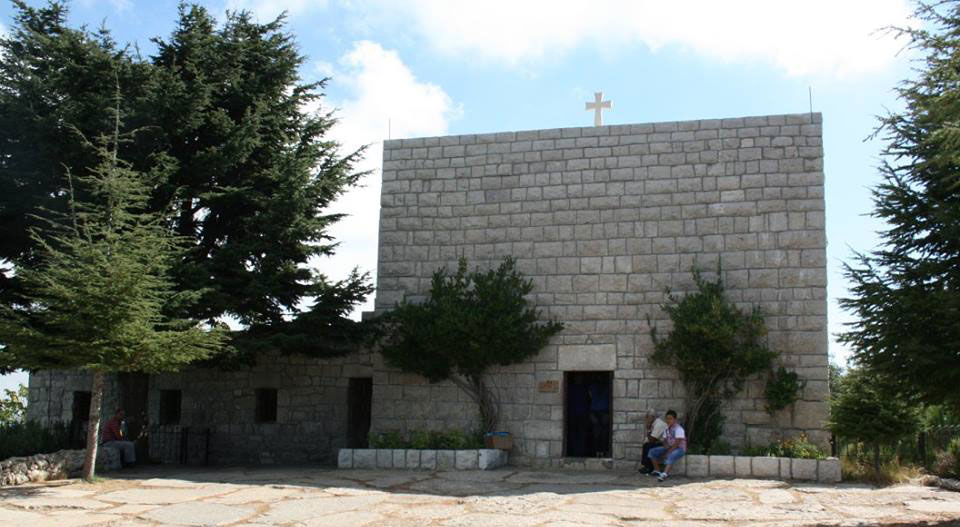
ST CHARBEL HISTORY (PART 9): DEATH & BURIAL
ST CHARBEL’S DEATH AND BURIAL
Father Charbel (St Charbel) suffered a stroke on December 16, 1898 while he was reciting the prayer of the Holy Liturgy: “Father of truth, behold Your Son, a sacrifice pleasing to You. Accept this offering of Him who died for me…”. As he fell to the floor, he kept his hands clasped around the Holy Eucharist.
His companion, Father Makarios Al-Mishmeshani the Hermit and some other monks helped him to his cell. Eight days later, on Christmas Eve, December 24, 1898, he died while murmuring the names of Jesus, His Blessed Mother Mary and St Joseph. This marked 23 years of solitude lived in total abandonment to God.
When Father Charbel (St Charbel) died, Father Antonios Mishmeshani, the Superior of the Monastery was away at the Patriarchate because Patriarch John Peter el-Hage was dying. When the Superior returned to find that Father Charbel (St Charbel) had died, he wrote prophetically about him. A paragraph from the Monastery’s official Death Record states:
“On this day, the 24th of December 1898, Father Charbel of Bekaa-Kafra, the Hermit, died of a stroke in the mercy of God after receiving the Sacraments of the Church. He was buried in the graveyard of the monastery at 68 years of age when I, Father Antonios Mishmeshani, was the Superior. Because of what he Charbel is going to accomplish after his death, I excuse myself from giving details of his life, especially in regard to the extent to which he kept his vows so that we can say his obedience was angelic and not human”.
The body of Father Charbel (St Charbel) was then laid out in the Church of the hermitage. The monks knelt near the body all night, praying and contemplating the life of their religious monk.
On the morning of Christmas Day, a small cortege of monks and people from neighboring villages left the hermitage. The procession set out towards the Monastery of St Maroun of Annaya for the burial ceremony, proceeding solemnly in prayer down the hill through the snow. The blessed body, clothed in the monk’s habit, was laid on a stretcher made of three wooden planks. As the procession moved toward the Monastery, a Priest incensed Father Charbel (St Charbel) body, while the mourners chanted in Syriac the psalms of the burial service.
As the cortege drew near to St Maroun monastery, the tolling of the bells could be heard more clearly. Despite the glacial and cold weather, the men and women villagers who had heard about Father Charbel’s (St Charbel) death came to pay their respects and obtain the blessing of the holy Father.
All the monks from the Monastery were waiting outside, reciting the rosary and chanting in Syriac “Open your doors, O Celestial Jerusalem!” The ceremony continued and the body was laid upon a catafalque draped with a pall in the nave of St Maroun’s Church. In keeping with custom, the monks and the people came forward one by one and kissed the hands of Father Charbel (St Charbel) . As the crowd and the assembly of monks left, the body was left alone in the church illuminated by candlelight.
Early the next morning, Father Charbel’s (St Charbel) body was carried to the grave located outside the monastery and adjacent to the wall of the church. After the Funeral Service was recited, a wooden board was lifted from a large pit which contained the bones of the other deceased monks. Then Father Charbel’s (St Charbel) body was lowered into the grave without a casket, covered only by his monk’s habit and hood with a Cross in his hands.
Water was dripping into the pit and mud covered its floor. Seeing the miserable condition of the grave, some monks and villagers asked that the body be buried in a private tomb or put in a coffin. However, the monk in charge explained that there was no exception to the rule. Father Charbel (St Charbel) was to be buried just like the other monks in the order. The grave was subsequently covered with a stone, sealed with concrete and then sprinkled with holy water.
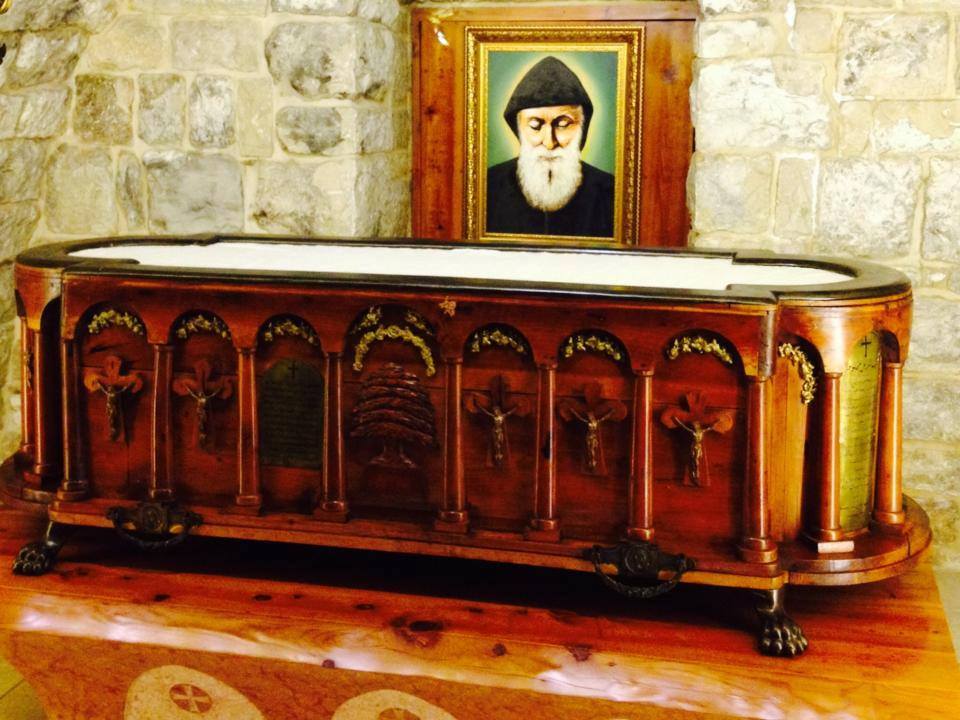
ST CHARBEL HISTORY (PART 10): BEATIFICATION & CANONISATION
ST CHARBEL’S BEATIFICATION AND CANONISATION
In the death records of the Monastery of St Maroun in Annaya, Father Charbel’s (St Charbel) superior wrote that because of what Charbel would accomplish after his death, he had no need to write about his life but was satisfied with stating that Charbel had kept his vows like an angel and not like a human.
Starting on the night of his death, Father Charbel’s (St Charbel) tomb emanated a bright light. After getting permission from the Catholic Church authorities, the Superior opened the tomb for the first time on April 15, 1899, four months after Father Charbel’s (St Charbel) death. Father Charbel’s (St Charbel) body was found to be intact and as of that day exuded a blood-like moisture for the next 67 years.
Between 1950 and 1975, Father Charbel’s (St Charbel) tomb was opened eight times and was examined by medical doctors in the presence of the Protector of the Faith and representatives of the Catholic Maronite Patriarch and of the Vatican, who found that his body still resembled a living one. Experts and doctors were unable to give any medical explanation for the incorruptibility and flexibility of the Father Charbel’s (St Charbel) body.
Father Charbel’s (St Charbel) tomb has been a site for millions of pilgrimages ever since the day he died. Hundreds of thousands of miracles were performed through the intercession of Father Charbel (St Charbel) in Annaya, Mount Lebanon and throughout the whole world.
By 1977, St Maroun’s Monastery in Annaya, Mount Lebanon had received 135,000 letters from 95 countries from around the world. They have come from people that wish to share the news of miracles, cures and wonders performed by Father Charbel (St Charbel).
Two cures which were considered miracles by the Catholic Church authorities were the healing of Sister Maria Abel Kamari S.S.C.C., who suffered from pain caused by an ulcer and the healing of Mr. Alessandro Obeid who had been blinded in his right eye following an accident. Both cures were instrumental in the beatification of Father Charbel (St Charbel) on December 5, 1965 and in his canonisation on October 9, 1977.
At the closing of the Second Vatican Council, on December 5, 1965, Father Charbel (St Charbel) was beatified by Pope Paul VI who said: “Great is the gladness in heaven and earth today for the beatification of Charbel Makhlouf, monk and hermit of the Lebanese Maronite Order. Great is the joy of the East and West for this son of Lebanon, admirable flower of sanctity blooming on the stem of the ancient monastic traditions of the East, and venerated today by the Church of Rome…. The holy monk of Annaya is presented as one who reminds us of the indispensable role of prayer, hidden virtues and penance…. A hermit from the Lebanese Mountain is enrolled among the blessed…a new, eminent member of monastic sanctity is enriching the entire Christian people by his example and his intercession…. In a world largely fascinated with riches and comfort, he helps us understand the paramount value of poverty, penance, and asceticism to liberate the soul in its ascent to God….”.
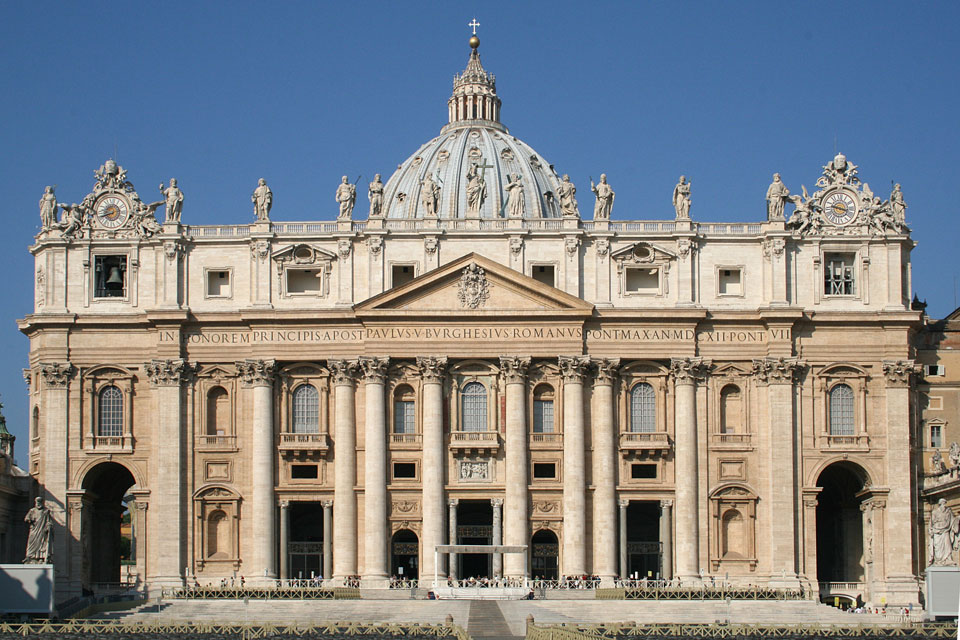
MARONITE HISTORY
OVERVIEW
St Maroun “The Little Lord” was a 4th century Catholic Priest and Hermit whose followers, after his death, founded a Catholic movement that became known as the Catholic Maronite Church. The Catholic community which grew from this movement are the Catholic Maronites.
St Maroun was born around 350AD in Cyrrhus, a small town near Antioch, Syria, was a Priest who later became a Hermit, retiring to the mountain of Taurus in the region of Cyrrhus. His holiness and miracles attracted many followers and drew attention throughout the empire.
St Maroun embraced a life of quiet solitude and was known for his simplicity and his extraordinary desire to discover God’s presence in all things.
St Maroun is often portrayed in a black habit garment with a hanging stole, accompanied by a long crosier staffed by a globe surmounted with a cross. His feast day is celebrated on February 9.

MONASTIC SPIRITUALITY
St Maroun’s way was deeply monastic with emphasis on the spiritual and ascetic aspects of living. For St Maroun, all was connected to God and God was connected to all. He did not separate the physical and spiritual world and actually used the physical world to deepen his faith and spiritual experience with God.
St Maroun was able to free himself from the physical world by his passion and fervour for prayer and enter into a mystical relationship of love with God. He lived his life in the open air and spent his time in prayer and meditation exposed to the forces of nature such as sun, rain, hail and snow.
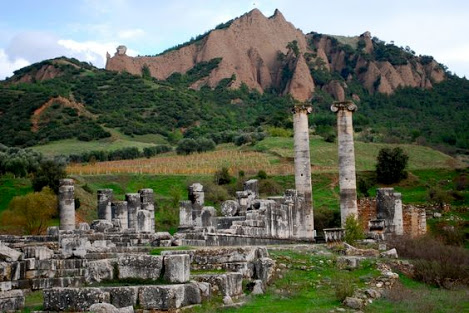
MISSIONARY
St Maroun was a mystic who started this new ascetic-spiritual method that attracted many people in Syria and Lebanon to become his disciples. Accompanying his deeply spiritual and ascetic life, he was a zealous missionary with a passion to spread the message of Christ by preaching it to all he met. He sought not only to cure the physical ailments that people suffered, but had a great quest for nurturing and healing the “lost souls” of both non-Christians and Christians of his time.
This missionary work came to fruition when in the mountains of Syria, St Maroun was able to convert a temple into a church. This was to be the beginning of the conversion to Christianity in Syria which would then influence and spread to Lebanon. After his death in the year 410AD, his spirit and teachings lived on through his disciples.
The Catholic Maronite faith reached Lebanon when St Maroun’s first disciple, Abraham of Cyrrhus, who was called the Apostle of Lebanon, realised that there were many non-Christians in Lebanon and so he set out to convert them to Christianity by introducing them to the way of St Maroun.
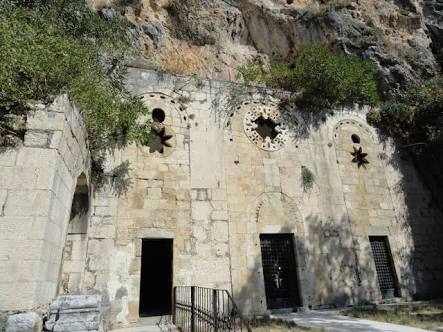
THREE SOURCES
We have three available sources regarding St Maroun’s Life. The first and most detailed source is from his biographer, Theodoret of Cyrrhus, who wrote “A history of the Monks of Syria” in the 5th century. The second is from St John Chrysostom, the “Golden Mouth”. The third is the Catholic Maronite Liturgy and the first Catholic Maronites:
1) Theodoret of Cyrrhus
Theodoret explains that pagans previously worshiped on the hill. St Maroun converted the hill to a place of Christianity and his “soul received the words of the Gospel.” He chose the “poverty of Christ over the riches of this world.” His asceticism (a life of abstinence) was also marked by a continued attachment to people. They came to him and St Maroun prayed and healed “not only the infirmities of the body, but applied suitable treatment to souls as well.” He set examples of chastity, prayer, meditation, labor and of course love. St Maroun example inspired many disciples, both men and women.
2) St John Chrysostom
The other source we have about St Maroun is St John Chrysostom. While in exile, and during one of the most difficult times of his life, St John Chrysostom wrote to St Maroun and asked him to pray for him. Below is an extract of the letter:
“Dear Maroun, we are bound to you by love and interior disposition, and see you here before us as if you were actually present. For such are the eyes of love; their vision is neither interrupted by distance nor dimmed by time… we address ourselves to your honour and assure you that we hold you constantly in our minds and carry you about in our souls wherever we may be… please pray for us.”
3) the Catholic Maronite Liturgy and the first Catholic Maronites
After St Maroun’s death, a great monastery was built in Syria in 452AD called Beit Maroun and the monastery flourished. However, from the 6th century, things became dangerous for the first Maronites and they were persecuted for their obedience to the Catholic faith and the Council of Chalcedon. In the year 517AD, 350 Catholic Maronite Monks were killed.
The Catholic Maronites, elected their first Patriarch, St John Maroun in the year 685AD. He was affirmed by Pope Sergius I, highlighting that the Catholic Maronite Church was in communion with Rome since the beginning.
In 694AD, 500 Catholic Maronites were killed and by 938AD Beit Maroun was completely destroyed and the Maronite Patriarch fled to the Mountains of Lebanon. The persecution resulted in many Catholic Maronites migrating from Syria to Mount Lebanon.
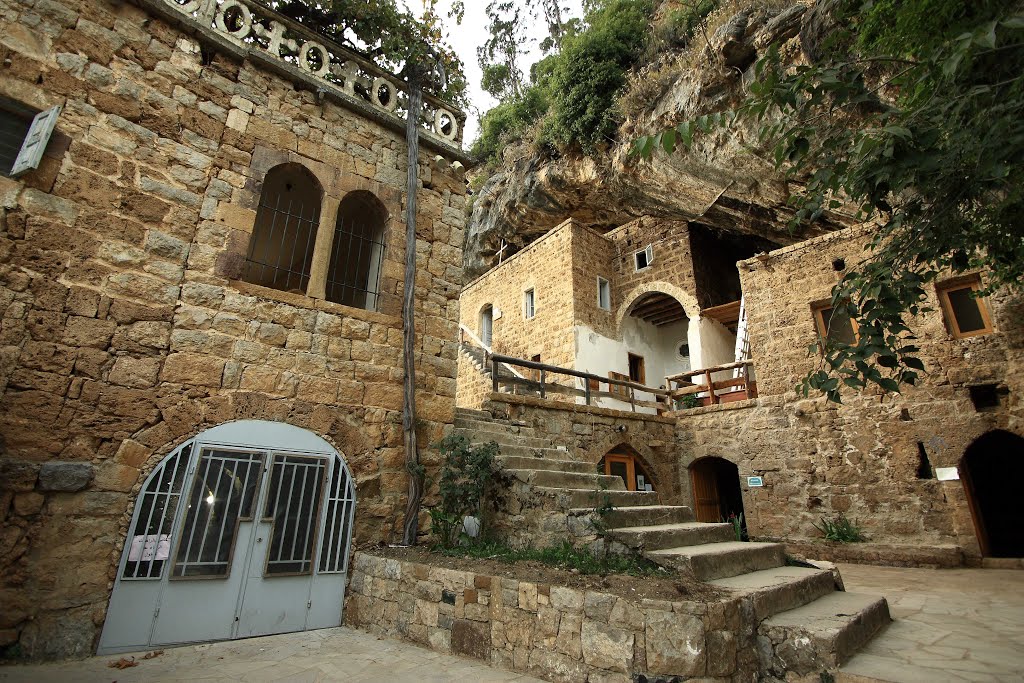
MARONITES IN THE MOUNTAINS OF LEBANON
The Catholic Maronite Church flourished in the rocky mountains under the Cedars of Lebanon and prospered in the hills and valleys of Qannoubine and Qadisha. By the 13th Century things once again became volatile for the Catholic Maronites. They were attacked in the north of Lebanon and in the Catholic Maronite villages of Ehden, Bsharre, Hadath El-Jibbe, Mayfouk and other villages.
Patriarch Daniel El Hadsheeti was killed and in 1367AD Patriarch Gabriel Hejola was burned alive. During that time many Catholic Maronites escaped to Cyprus where there was a Catholic Maronite Church. In 1440AD, to escape persecution, the Catholic Maronite Patriarchate moved from Mayfouk to Wadi Qannoubine, where it took refuge.
In 1860, under the Ottoman rule, many villages, churches, and monasteries were completely destroyed. During this time many Maronites were martyred. On July 10, 1860, the Massabki brothers: Francis, Abed El-Moati, and Raphael were martyred in Damascus. They remained steadfast in the face of persecution and refused to deny their faith. Pope Pius XI beatified them on October 1, 1926.
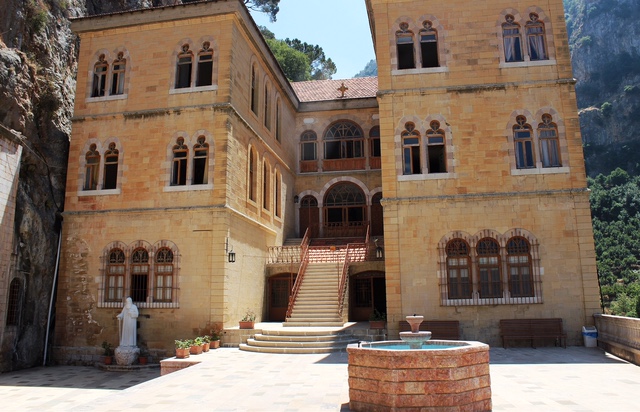
THE MARONITES OF THE EXPANSION
By 1915, Ottomon rule, famine, disease and war created a great wave of migration in particular to the Americas. Many Catholic Maronites became scattered throughout the world, which made the Church grow outside of Lebanon. The Catholic Maronite Church became international. No longer were they Maronites of the Middle East, but also American, South American, European, African and Australian Catholic Maronites.
Patriarch Daniel El Hadsheeti was killed and in 1367AD Patriarch Gabriel Hejola was burned alive. During that time many Catholic Maronites escaped to Cyprus where there was a Catholic Maronite Church. In 1440AD, to escape persecution, the Catholic Maronite Patriarchate moved from Mayfouk to Wadi Qannoubine, where it took refuge.
In 1860, under the Ottoman rule, many villages, churches, and monasteries were completely destroyed. During this time many Maronites were martyred. On July 10, 1860, the Massabki brothers: Francis, Abed El-Moati, and Raphael were martyred in Damascus. They remained steadfast in the face of persecution and refused to deny their faith. Pope Pius XI beatified them on October 1, 1926.
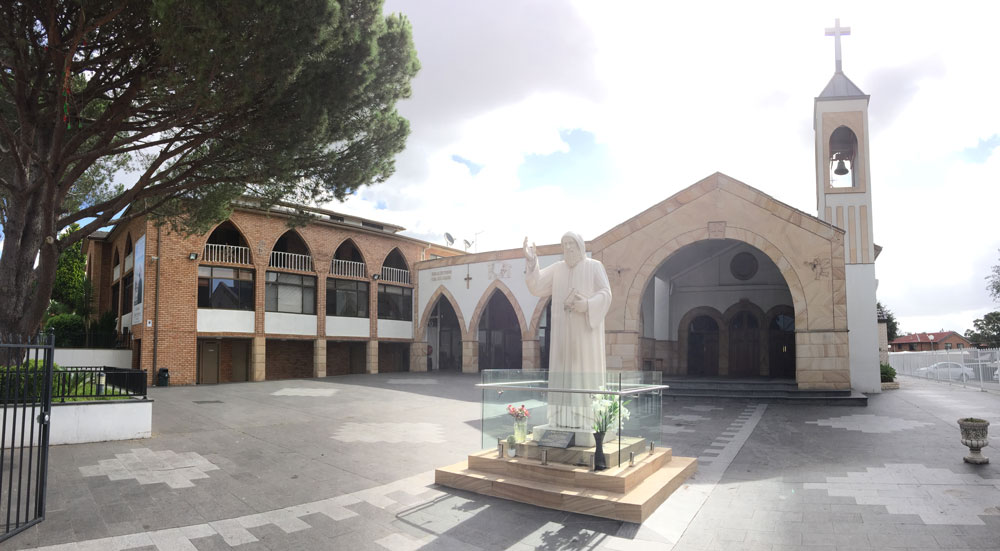
THE IMPORTANCE OF MAINTAINING OUR CATHOLIC MARONITE TRADITIONS
Our Catholic Maronite ancestors overcame great persecution to protect their Church and their faith. They remained steadfast in the face of persecution and committed to Christ and St Maroun. Their shield was prayer. Out of their experience developed a superb liturgy and many beautiful traditions.
We are called by the Universal Catholic Church to protect those traditions. In his very beautiful Apostolic letter, Orientale Lumen, Blessed Pope John Paul II declared.
“…I listen to the Churches of the East, which I know are living interpreters of the treasure of tradition they preserve. In contemplating it, before my eyes appear elements of great significance for fuller and more thorough understanding of the Christian experience…the Christian East has a unique and privileged role as the original setting where the Church was born… Tradition is the heritage of Christ’s Church…Tradition is never pure nostalgia for things or forms past, nor regret for lost privileges, but the living memory of the Bride, kept eternally youthful by the Love that dwells within her.”
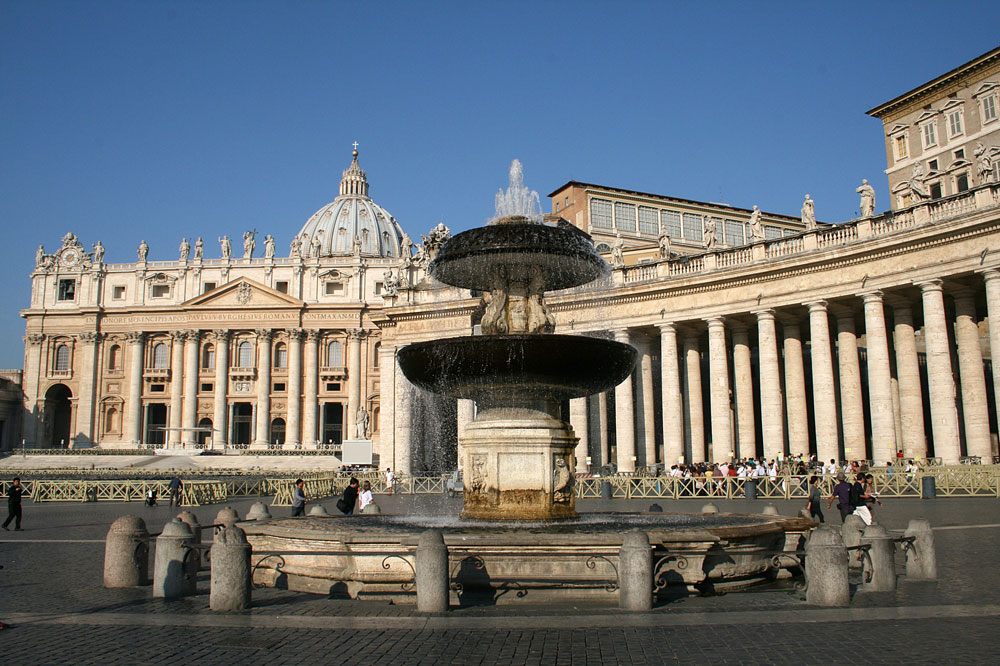
St. Maroun Portrait
